Leas Lift, Folkestone
TODAY'S ITINERARY
Exploration: Monday, 24 June, 2019
lv London St Pancras 1437 Southeastern
ar Folkestone 1530
lv Folkestone 1726 Southeastern
ar Dover Priory 1737
lv Dover Priory 1749 Southeastern
ar London St Pancras 1854
The same day that I inspected the not funicular at Southend-on-Sea, I also went to the not-working funicular at Folkestone. Because the train runs most of the way on "High Speed 1", you can get from London to Folkestone in just over an hour. This is the same railway with a 140 miles per hour speed limit that is used by the Eurostar trains that cross the channel to Europe.
I had been to Folkestone before, to change to the bus for Hythe to reach the Romney, Hythe and Dymchurch Railway. If you go to see the Leas Lift, you should consider going to the RH&DR the same day. The meticulously maintained small railway is a treat. A bus runs a few times an hour from the Folkestone bus station to a stop very close to the railway terminal. I give here a picture from my 2017 visit.
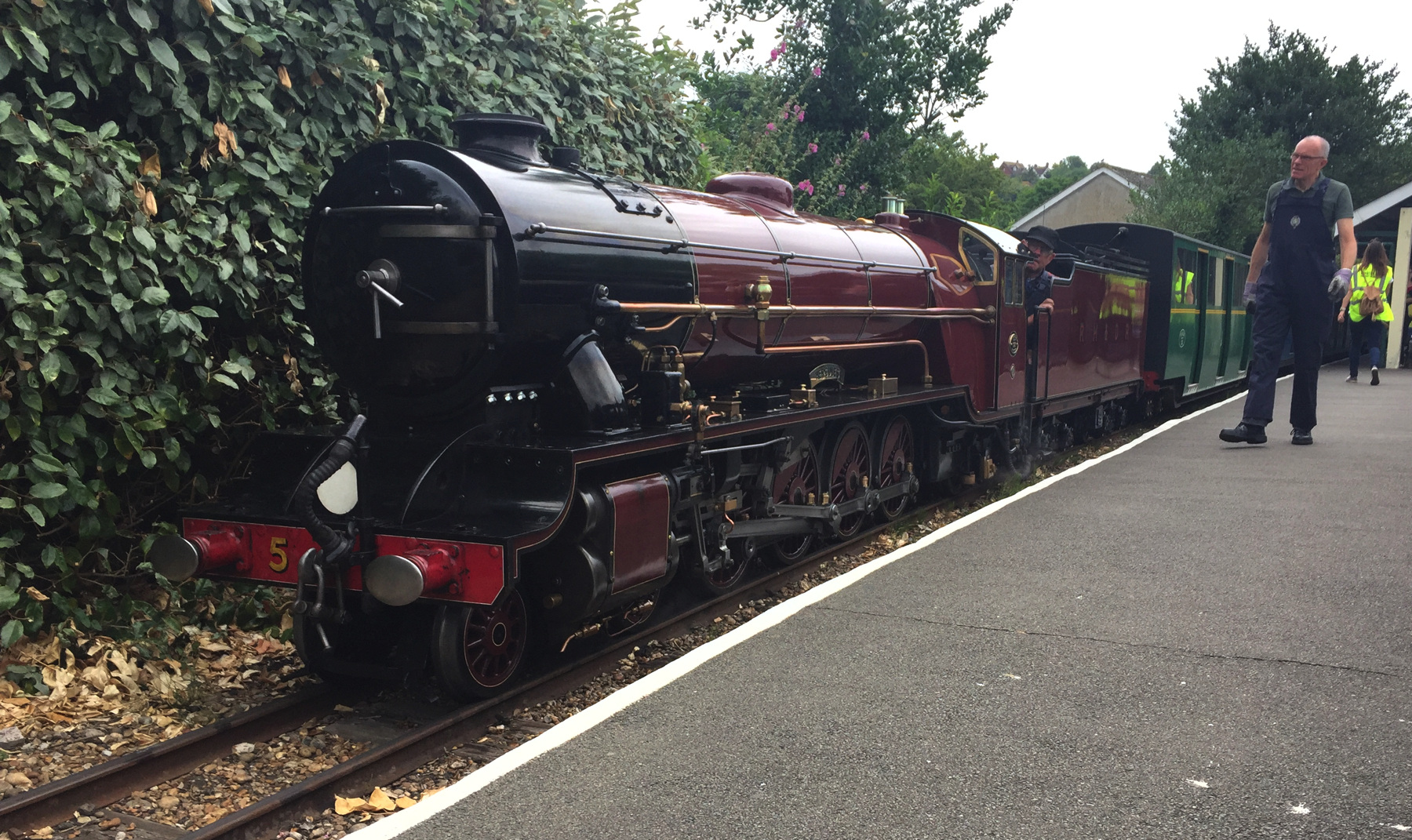
The building at Folkestone Central station was replaced in 1961, and the architecture is so dull I forgot to take any photo of it. The most direct way from the station to the Leas is along Cheriton Road, into Cheriton Gardens, into Cheriton Place, streets that get increasingly narrow as you go. The Leas is the local name of the cliff above the coast, and also the name of the broad promenade along the top.
From the end of Cheriton Place you will see to the east the Step Short Memorial Arch, placed in 2014 to remember the troops that passed through Folkestone to the ships a hundred years earlier, many of them to die in the first world war. Slope Road beyond the arch, now named the Road of Remembrance, is very steep and the soldiers were ordered to "step short" to go down safely.
If you walk toward the arch, before you reach it you will find the closed upper station of the Leas Lift.
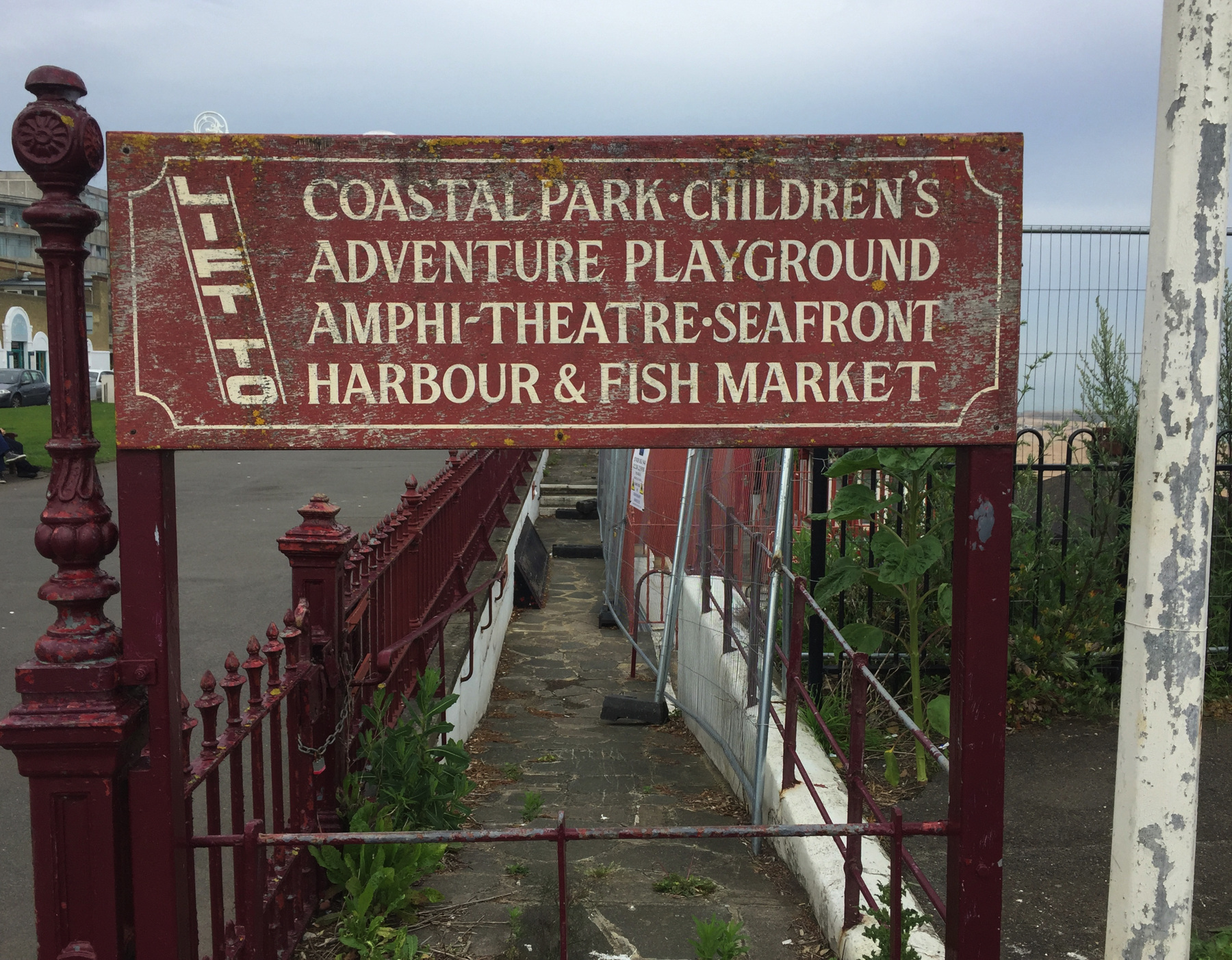
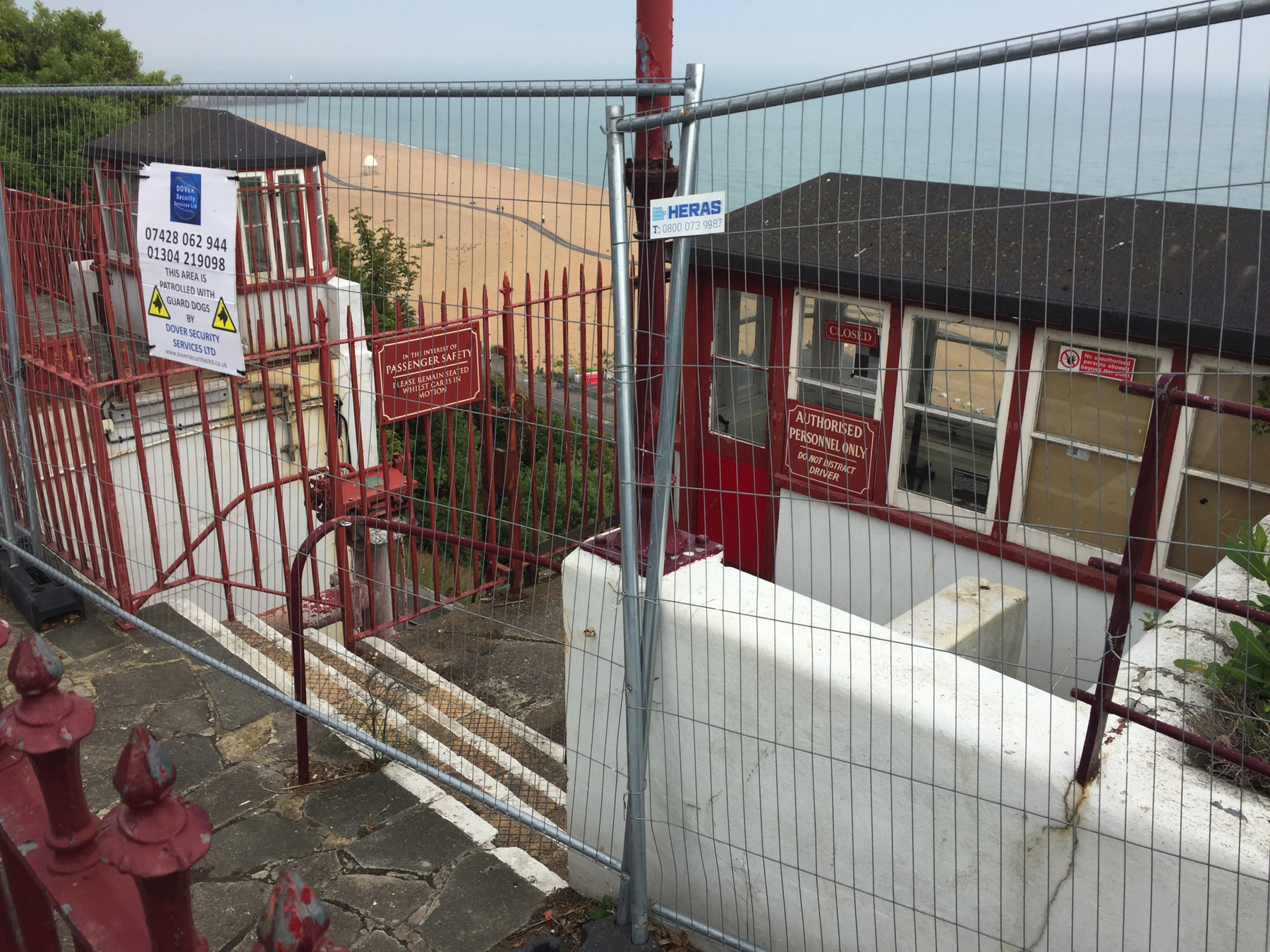
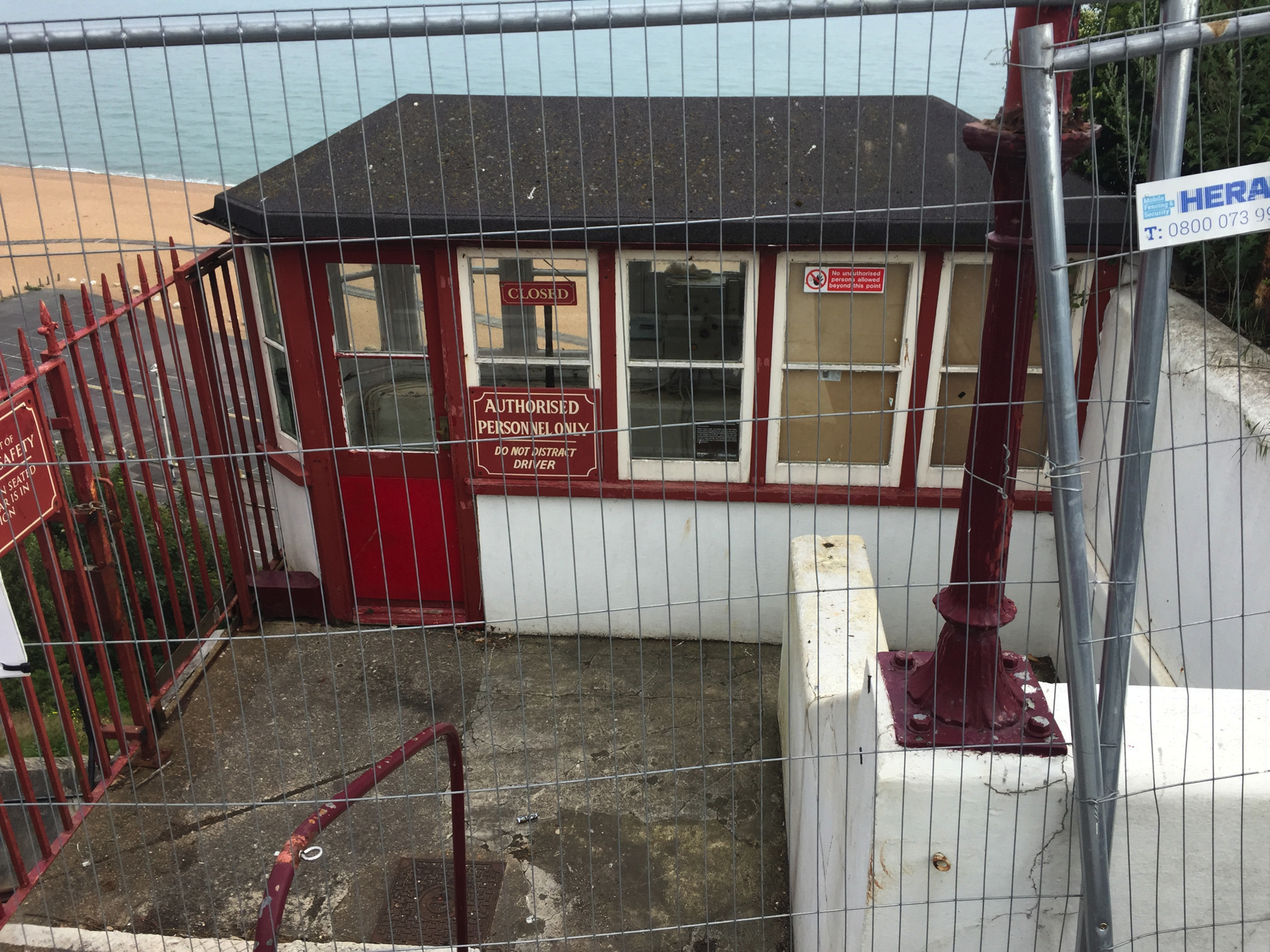
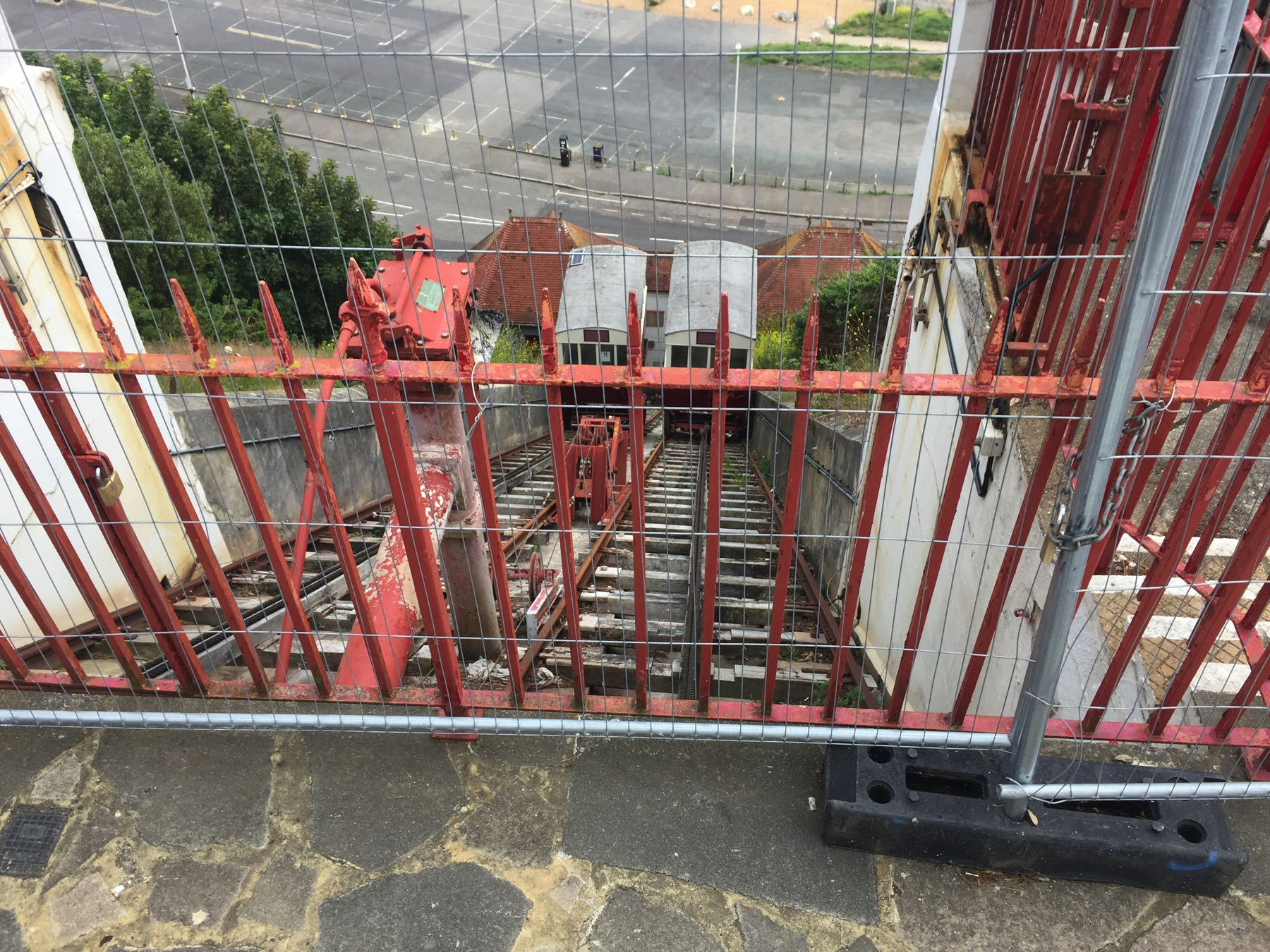
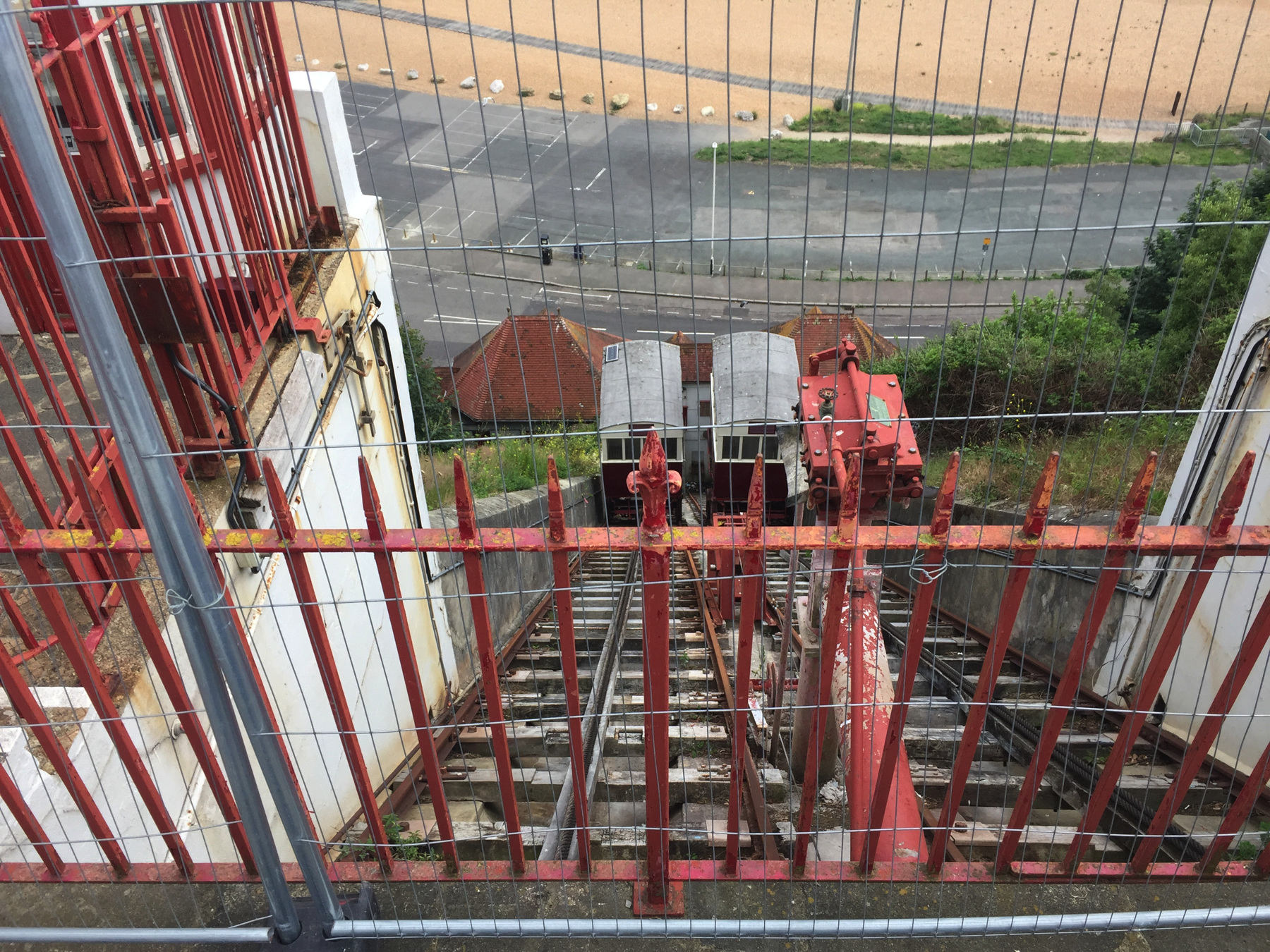
The two cars are still there, braked to a stop in the middle where they balance each other. The doors are on the side of the cars, not at the ends, so the stations have a short platform on each side of the double track. My photos above show mostly the west side platform but you can see the gate from the other platform in the last picture.
The very solid looking concrete structure under the platforms contains the water tanks. This was a water balanced funicular, like the ones at Lynton and Saltburn. The big pipe between the tracks was used to fill the car's tank.
But what happened? Leas Lift was in operation from 1885 to 2009, when the local council decided it cost too much to subsidize it. After much protest there was a change of heart and an infusion of money from charitable trusts. The entire property was renovated and restored during 2010 by work that won two ACE Engineering Excellence Awards in 2011. The lift reopened at the start of that year only to close again at the start of 2017 when the national Health and Safety Executive required a secondary braking system to be installed.
In October 2018 the Folkestone Harbour and Development Company pledged £500,000 toward reopening Leas Lift, which far exceeds published estimates for adding the brake system, but news in June 2019 was that other work was also needed, bringing the total needed to £750,000. Donations are still being sought, and that's the story as of this writing in late 2019. I am at a loss how an award winning renovation in 2010 could be so deficient that it needs so much spent on it just a few years later. But what do I know?
I walked past the arch and partway down the Road of Remembrance, and then into a steep footpath to reach the flat ground along the beach. There I found an old row of houses called Marine Crescent and large empty parking lots. For a beach in June it was a lonely spot. I did not see the Coastal Park · Children's Adventure Playground · Amphi-Theatre · Seafront · Harbour & Fish Market advertised in the sign at the upper station— a sign that is not very old. The Ordnance Survey map dated 1906 shows, west of Marine Crescent, a large building marked Baths, a camera obscura opposite the Leas Lift station, Victoria Pier just west of that with a Pavilion at the outer end, and a Switchback (an early amusement ride), as well as some smaller buildings without names. A short stroll past the shunned parking lots brought me to the lower station.
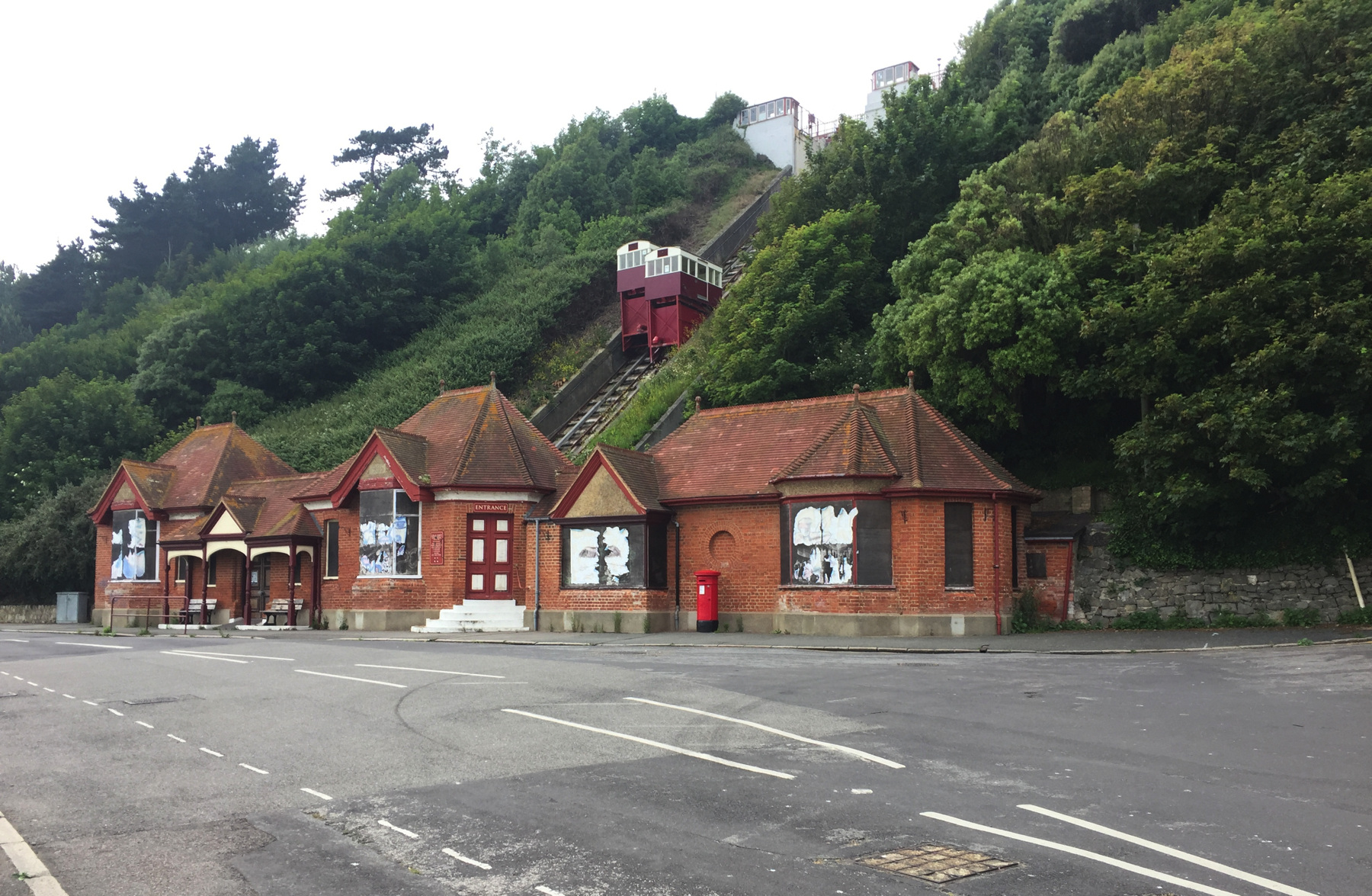
The photos from below show very well the water tanks under the cars. They show something else too: the path of the second funicular, separated by a grassy slope. Just as the Central Tramway in Scarborough had to be supplemented by the St Nicholas Cliff Lift to handle the summer crowds, the Leas Lift needed more capacity, and in this case there was ground available to lay the second pair of tracks right next to the first, making this the only double-barrelled four-track funicular I knew of (until I went to Bristol). The second one was only five years later than the first, but for some reason it had a different track gauge and cars of a different design, with a stepped floor and doors at the ends. It ran from 1890 to 1966, and the track was not lifted until 2013.
The lower station was at first symmetrical, with double doors under a portico in the central section, and twin wings on each side. The addition seen on the right was built with the second funicular, almost matching the overall style but breaking the symmetry. The new structure has the engine house that pumps water back up to the tanks at the top. Before 1890 the water was released into the sea (as they still do at Lynmouth, where there is a steadier source of fresh water at the top). I cannot explain the date 1985 on the east wing.
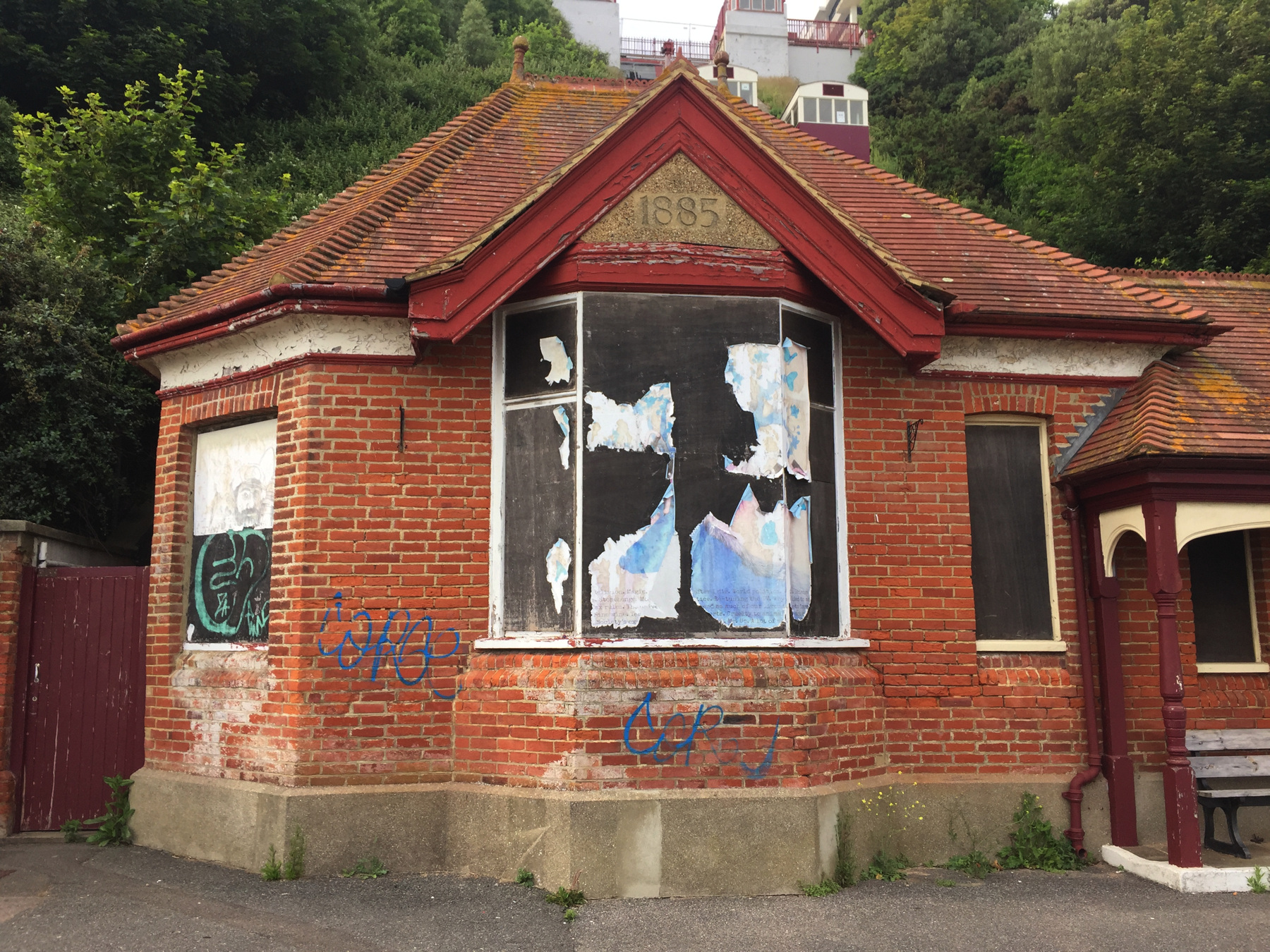
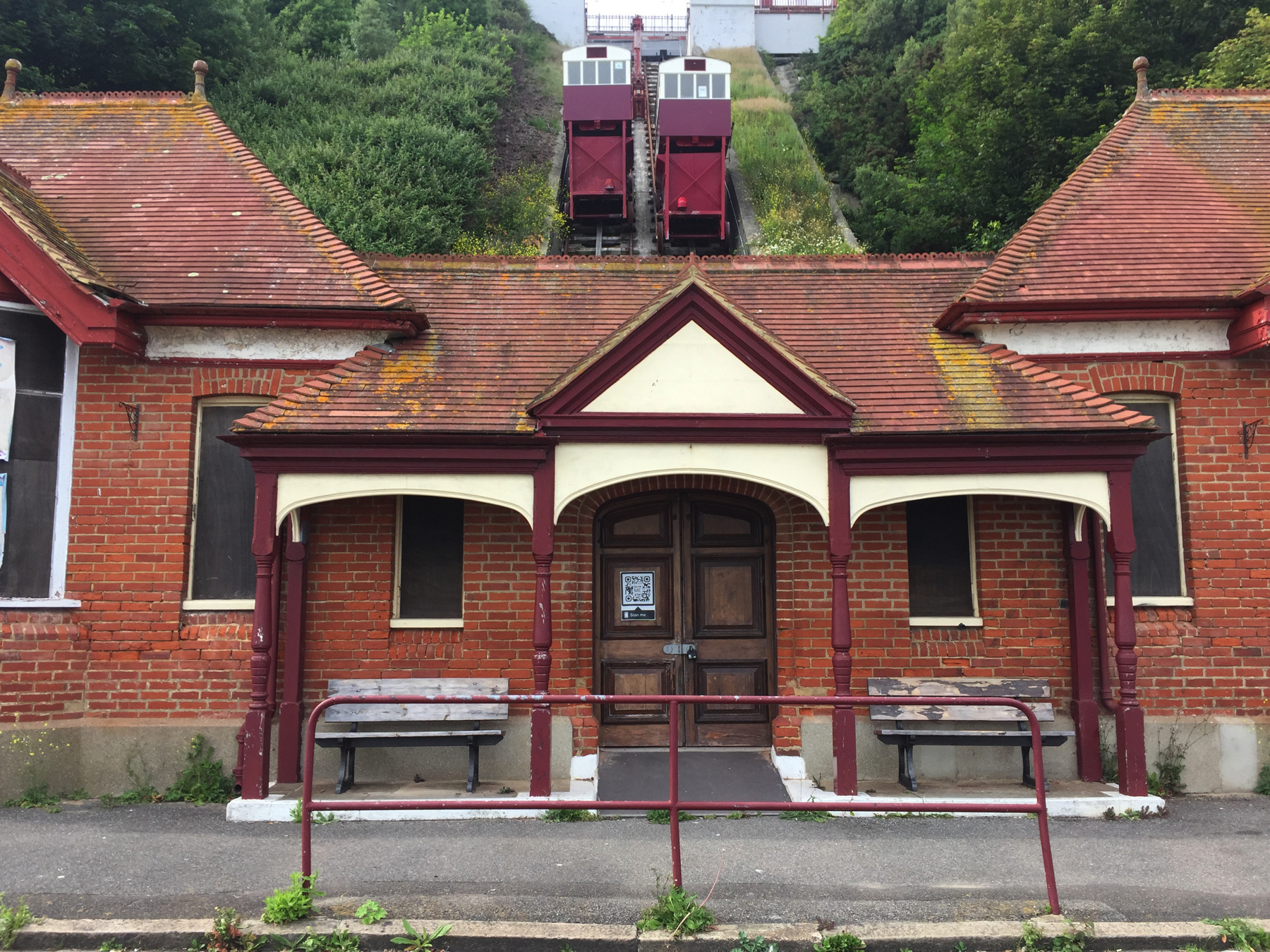
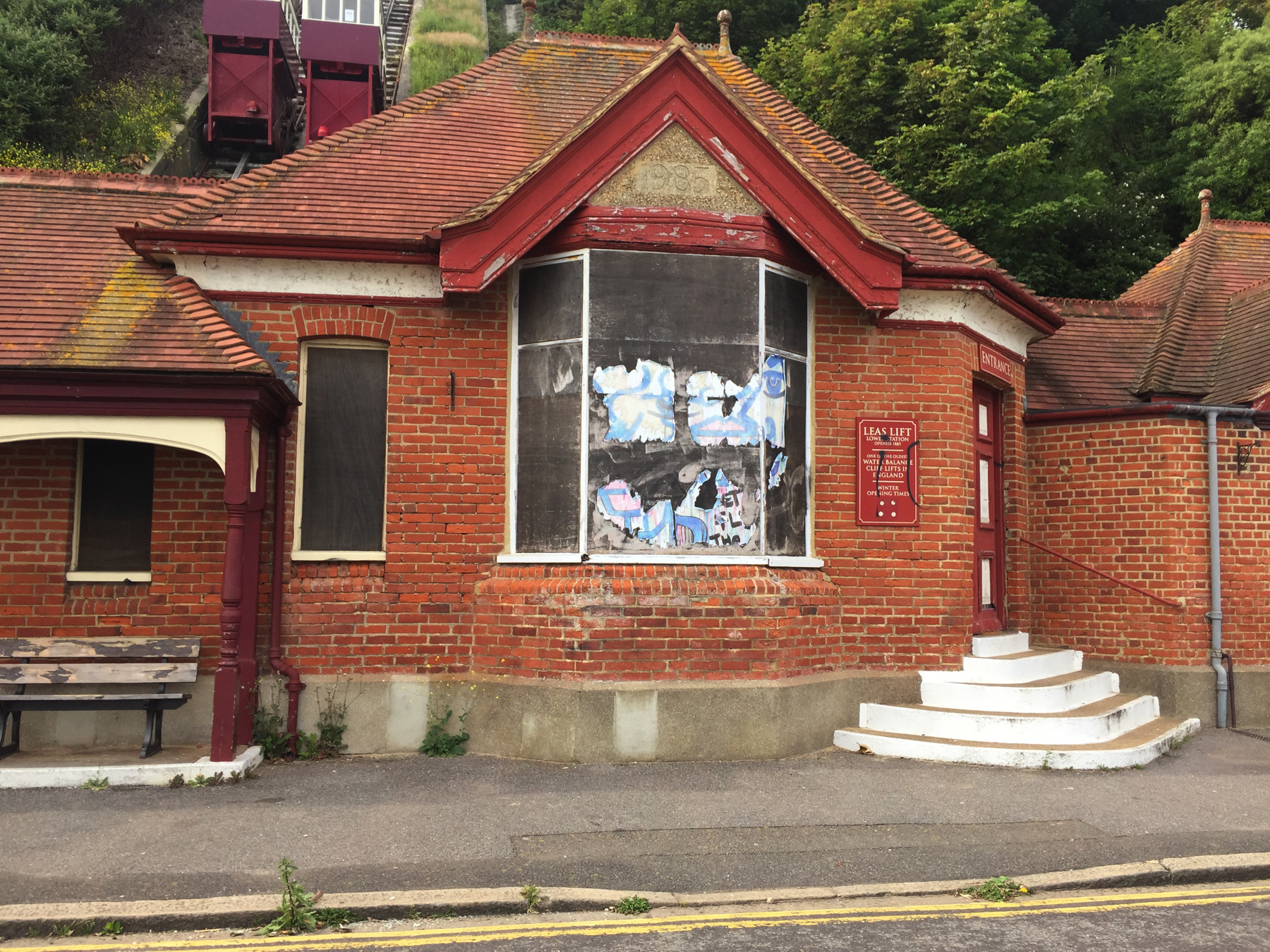
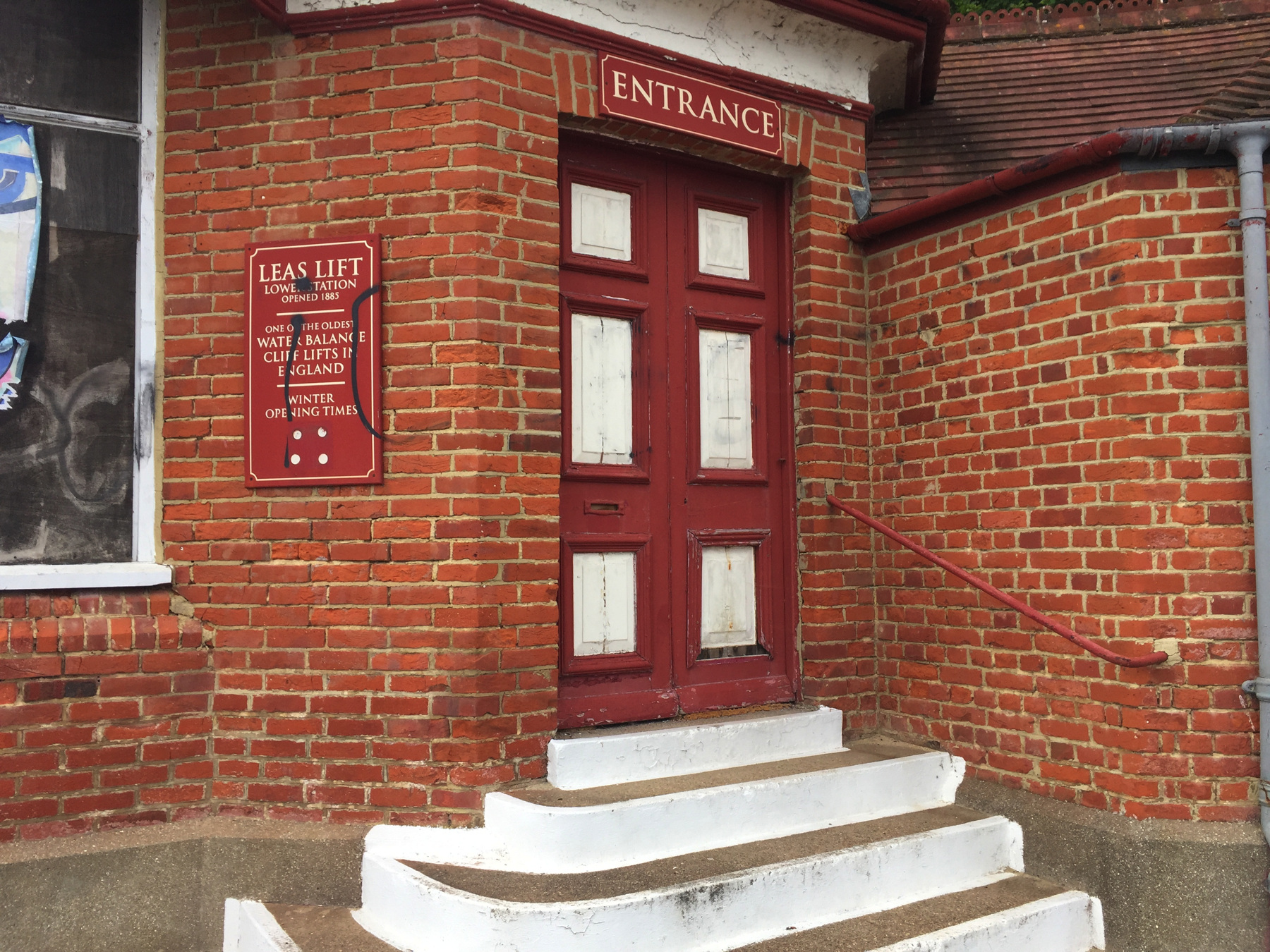
I walked way out on the beach for this last view of the scene. You can see I did not need to push my way through crowds... nothing like that.
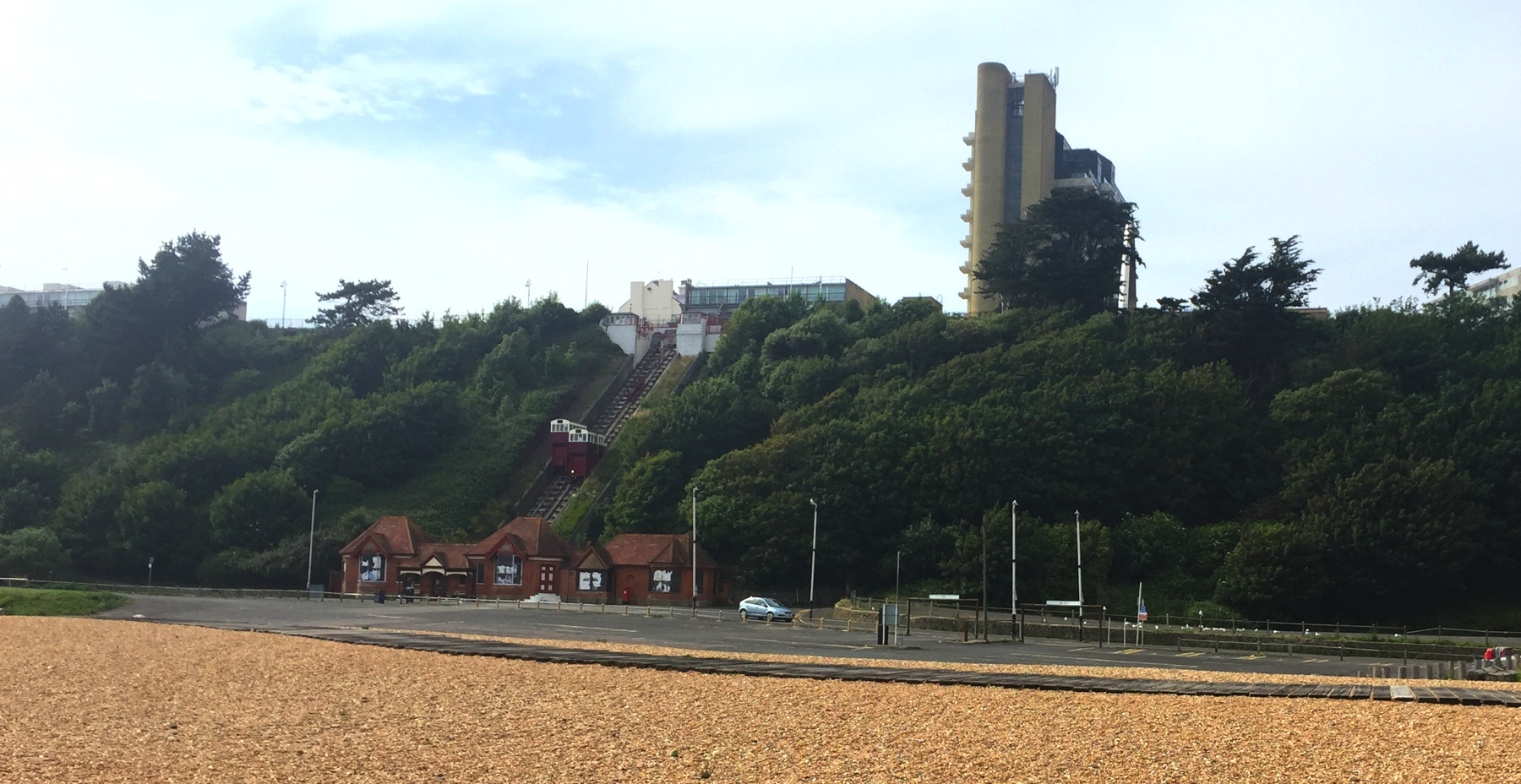
I went back up the same footpath and the Road of Remembrance, but from there I wanted to see a little of old Folkestone. I walked in streets called Pound Way, West Cliff Gardens, St Eanswythe's Church Path [note 1], The Bayle, Bayle Street, The Old High Street, Rendezvous Street, and Guildhall Street— or something like that. Some of the old streets were closed to traffic and some others were so narrow that they might as well be. As in many towns it was a mix of old buildings and new neighbors. At five o'clock many of the shops were closing. After the stroll I put my trust in traffic signals to cross a wide intersection, and came into Cheriton Road and on to the station.
My itinerary going back may look odd. Remember I had a Britrail pass, so I could ride any train. Arriving at Folkestone Central at a random time, it so happened that I would need to wait a while for the next train to St Pancras. I found that the schedules would allow me time to ride to Dover Priory and catch the same train to St Pancras from there. I had been to Dover years ago but never by the interesting route through the white cliffs from Folkestone.
The railway drops down gradually as it goes east, reaching an elevation not much above sea level by the time it runs along the cliffs. There is a high viaduct at Foord Road, and sidings at the entrance to the former Folkestone Harbour branch, which faces toward Dover. The right of way of the branch is intact, and there are dreams of making it anything from a short heritage railway to a footpath. Near the harbor, recently some of it has in fact become a footpath, and the Folkestone Harbour and Development Company are creating hotel, restaurant, and entertainment properties. This is the same development company I mentioned as offering finance for the funicular. My walk took me very close to all this and I didn't realize it.
The railway continues in a series of tunnels cut into the chalk, with views of the Channel between them. It is in tunnel where it crosses far over the Channel Tunnel. After only ten minutes the railway curves sharply north and with one last tunnel we were in Dover Priory. I had twelve minutes to watch a few trains move in and out, and then I boarded my train, stopping at Folkestone again on the way.
[note 1] With a lengthy Catholic school education I thought I'd heard of every saint's name there is, but Britain keeps throwing new ones at me. St Swithun, St Tudno... and now, St Eanswythe. The Abbess of Folkestone was the daughter of the Saxon King Eadbald of Kent, a pagan, and his wife, a Frankish princess, very likely a Christian. Their daughter was born in 614 or so, as Christianity was being re-introduced to Britain after the Saxons had nearly wiped it out. Eadbald, a convert, built a monastery at Eanswythe's request in 630, but since she was just 16 she was not immediately made abbess. (St Hilda became the founding abbess at Whitby in 657, quite a bit later.) Not much else is known. Eanswythe is said to have given sight to a blind man and to have cast out a demon. Two scenes in stained glass in the church of St Mary and St Eanswythe show miracles of Eanswythe. In one she "causes a stream of water to be diverted to the service of her nunnery" and in the other she "forbids the birds to settle on her fields and destroy her crops". Both these strike me as a bit selfish. Eanswythe died young in 640. The site of the monastery was eventually taken by the sea, and Eanswythe's relics were twice moved farther inland, the last time in 1138. In 1535 the priory like others was dissolved by Henry VIII and its contents plundered. But in 1885 workmen doing repairs in the church found in a plastered-over niche in the wall a lead reliquary containing bones that could be those of a small woman, and from that it was concluded that they were relics of Eanswythe, hidden from marauders in 1535. They were put back and are now behind metal doors in the wall. Very few churches in England contain relics of their own patron saint. I walked right past the church, and knowing nothing of this I walked on.